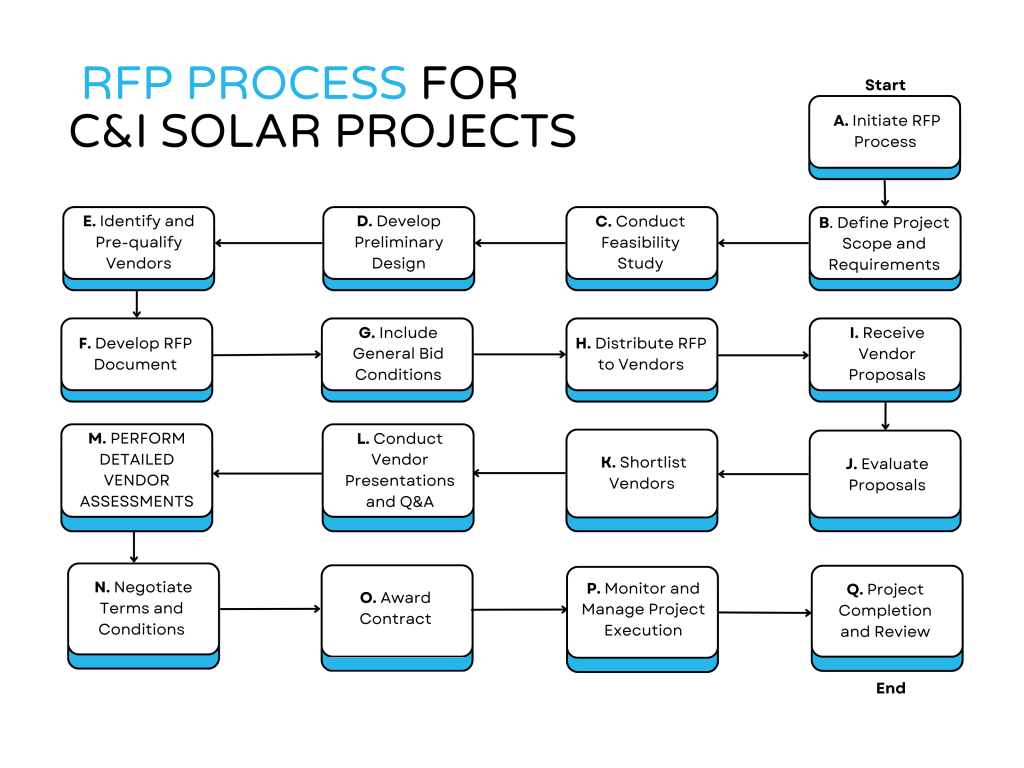Introduction
In the Commercial & Industrial (C&I) sector, the adoption of solar energy projects is gaining momentum as businesses seek to reduce energy costs, improve sustainability, and hedge against energy price volatility. However, the successful implementation of these projects hinges on a well-structured Request for Proposal (RFP) process. An effective RFP process ensures that the right vendors are selected, projects are completed on time and within budget, and the expected energy savings and environmental benefits are realized.
To achieve these outcomes, clients, advisors, and other stakeholders must approach the RFP process with greater rigor and a deeper understanding of its complexities. This involves:
- Comprehensive Feasibility Studies: Assessing technical, financial, and regulatory aspects to ensure the project is viable from the outset.
- Detailed Preliminary Design: Developing a robust preliminary design that accurately reflects the site conditions and project requirements.
- Clear and Comprehensive RFP Documentation: Providing potential bidders with all necessary information and clear evaluation criteria to facilitate accurate and competitive proposals.
- Inclusion of PPA Terms: For projects undertaken as Power Purchase Agreements (PPAs), clearly outlining the terms and conditions to attract credible and financially stable bidders.
- Stakeholder Engagement: Ensuring that all relevant parties, including regulatory bodies, community groups, and internal teams, are involved early in the process to address potential challenges and streamline approvals.
Flowchart of the RFP Process for C&I Solar Projects

Detailed Steps
1. Conduct Feasibility Study
- Site Assessment: Evaluate potential sites, considering solar irradiance, roof or land availability, shading, and structural integrity.
- Technical Feasibility: Assess grid connectivity, infrastructure needs, and potential challenges specific to C&I sites.
- Financial Feasibility: Estimate project costs, potential funding sources, and expected ROI. Evaluate the financial viability of a PPA model.
- Regulatory Compliance: Ensure compliance with local, regional, and national regulations. Obtain necessary permits and approvals.
2. Develop Preliminary Design
- System Design: Create a preliminary design for the solar system, including the layout of solar panels, inverters, and other components tailored for C&I applications.
- Energy Yield Analysis: Estimate expected energy production based on the preliminary design and site conditions.
- Technical Specifications: Define technical specifications for key components, such as solar panels, inverters, and mounting structures.
- Budget Estimate: Provide a preliminary budget estimate based on the design and specifications, including financial models for both direct purchase and PPA options.
3. Develop RFP Document
- Project Overview: Include a detailed description of the project, its objectives, and scope. Highlight the benefits of the solar project for the C&I sector.
- Technical Requirements: Specify technical requirements and standards that bidders must meet, including performance metrics and system warranties.
- PPA Terms: Outline terms and conditions for the PPA, including pricing, contract duration, and termination clauses.
- Submission Guidelines: Outline format and content requirements for proposals, including deadlines and submission procedures.
- Evaluation Criteria: Define criteria and weightings for proposal evaluation, considering both technical and financial aspects.
4. Include General Bid Conditions
- Bid Bond: Specify requirement for a bid bond to ensure serious bids.
- Performance Bond: Detail performance bond requirements to guarantee project completion.
- Warranty Requirements: Specify warranty terms for equipment and installation services, tailored to the C&I market.
- Timeline: Provide expected project timeline, including key milestones and deadlines.
- Payment Terms: Outline payment schedule and terms for the awarded contract, considering both direct purchase and PPA models.
- Contract Terms: Include general terms and conditions of the contract that will be awarded.
Challenges and Constraints
For Project Owners/Developers:
- Comprehensive Feasibility: Ensuring thorough feasibility studies specific to C&I sites, which can vary widely in terms of roof conditions, shading, and energy needs.
- Accurate Preliminary Design: Developing a preliminary design that accurately reflects the project scope and constraints can be challenging without detailed site data.
- Detailed Bid Conditions: Defining comprehensive and clear bid conditions to avoid ambiguity and ensure fair evaluation can be complex.
- PPA Contracting: Structuring a PPA that is financially viable and acceptable to all stakeholders can be challenging.
For Vendors/Suppliers:
- Adhering to Requirements: Meeting all technical, financial, and regulatory requirements in the RFP can be demanding.
- Proposal Costs: The detailed information required in the RFP can increase the time and cost of proposal preparation.
- Competitive Pressure: Balancing competitive pricing with the need to meet all bid conditions and ensure project viability.
For PPA Providers:
- Risk Management: Assessing and managing the financial and operational risks associated with long-term PPA contracts.
- Customer Creditworthiness: Evaluating the creditworthiness of C&I customers to ensure reliable payments over the contract term.
- Regulatory Changes: Adapting to regulatory changes that could impact the financial attractiveness of PPAs.
Addressing Challenges
- Thorough Planning: Investing time in detailed feasibility studies and preliminary design to reduce uncertainties later in the process.
- Clear Documentation: Providing clear and detailed RFP documents and bid conditions to ensure vendors understand requirements.
- Stakeholder Collaboration: Engaging stakeholders early to align expectations and address potential challenges collaboratively.
- Realistic Timelines: Allowing adequate time for each phase of the process, from feasibility studies to vendor evaluation, to ensure thorough and accurate work.
- PPA Structuring: Working with experienced financial and legal advisors to structure PPAs that balance risk and reward for both parties.
By approaching the RFP process with this level of rigor and understanding, stakeholders can significantly enhance the efficiency and effectiveness of solar projects in the C&I space, ensuring successful outcomes and long-term benefits.

